
How to use digital experience management and ITSM optimization to boost efficiency and help cut down on costly onsite visits
Exactly one year ago, I was creating field support solutions for organizations across the globe and it troubled me to see so much money spent on inefficient dispatch visits (meaning visits on an hourly basis) for in-person support resolutions.
There had to be a better approach for both the customers and the field support organization.
These visits were often costly for a few reasons:
- Frequently an onsite visit would only require 30-35 minutes of touch support from the field technicians, but the minimum amount to be paid would be an hour, which would cost clients about $90-$110 per hour.
- The technician had to commute to the user location. And once COVID-19 protocols started, it became more difficult and costly as technicians would have to wear a PPE kit every time they did a field visit.
- It would also often happen that a technician would visit a user at a location for an hour one day only to return the next day for another visit at the same location for some other user.
However, if the technician spent a full day (i.e., eight hours) onsite, the cost would be approximately $400-$450 — much less than the hourly rate.
Given these conditions, wouldn’t it be better if the technician could resolve all the issues at a single location on the same day?
This would potentially save a lot of cost to the customers and make the technician’s job much more efficient.
BLOG POST
3 IT Service Desk Pitfalls and How to Avoid Them
An Optimized Approach to Global Field Support
When I joined Lakeside, I realized that driving field support efficiencies is simple with the right data and insights. With Lakeside’s Digital Experience Cloud, powered by SysTrack, you can analyze each user’s end-user experience score, top problems they are facing, and potential issues that might affect their device in the near future with device performance history and asset location details.
Once the health scores of any location breaches the threshold, an alert can be generated that triggers an action with the IT team to create a proactive onsite visit and logs an auto-ticket in the customer ITSM tool as well.
The IT team can do the initial remediation remotely using the Digital Experience Cloud’s analytics and automations to restart machines and services, clean up disk space, and more. However, if a resolution can’t be reached remotely, a field technician visit can be arranged for that location. Organizations can also alert users that a technician will be visiting using SysTrack Announcements and Engagements.
An example Engagement might read: “We have observed that you are experiencing issues with your device and have scheduled a proactive field tech visit for your location. Please click on the link below to schedule an appointment.”
After clicking the link, a user could be taken to the scheduling module of their native ITSM tool, such as ServiceNow, where they can book a visit.
With this approach, all of the issues at a location ring can be resolved in a single-day, onsite visit.
Additionally, with the Digital Experience Cloud’s real-time and historic health and performance data from end-user devices, technicians can gain insights prior to the visit and arrive at the location with any necessary preparations, such as spare hardware already accounted for.
Rethink Your Global Field Support Strategy
By adopting a proactive field support model with Lakeside’s Digital Experience Cloud, organizations can achieve significant savings by not overpaying for inefficient services. Instead, technician hours can be optimized to use the full-day rate or even resolve the issue remotely, reducing the number of onsite visits while improving end-user productivity.
More Ways to Work Smarter, Not Harder
Explore how Lakeside can help optimize your organization’s service desk for greater performance and efficiency. Schedule a customized demo.
Subscribe to the Lakeside Newsletter
Receive platform tips, release updates, news and more






